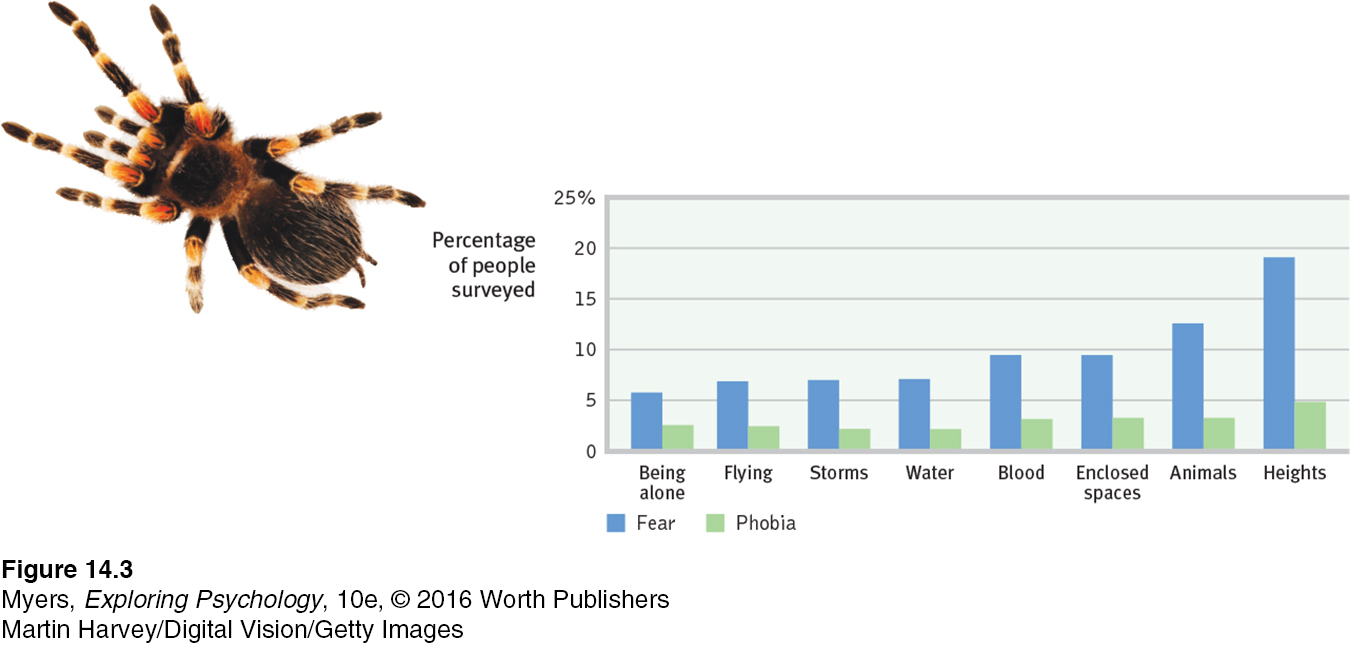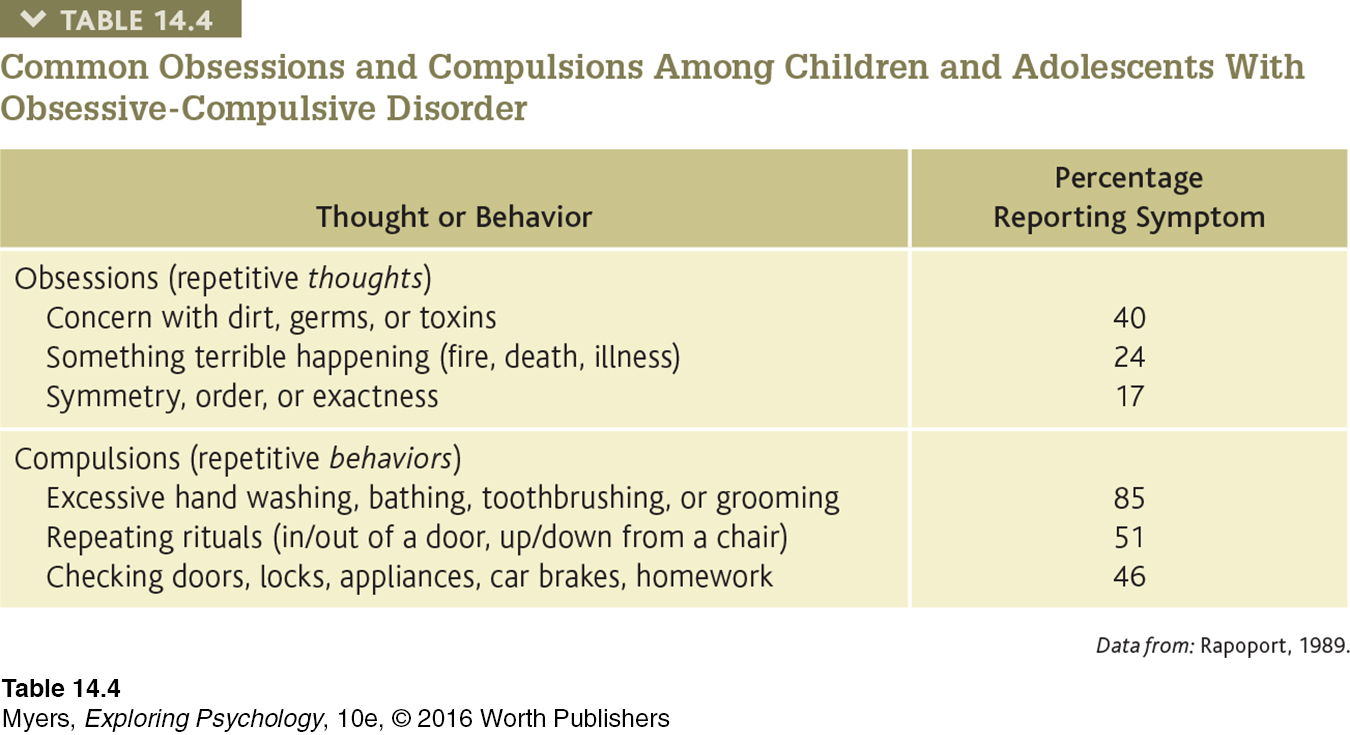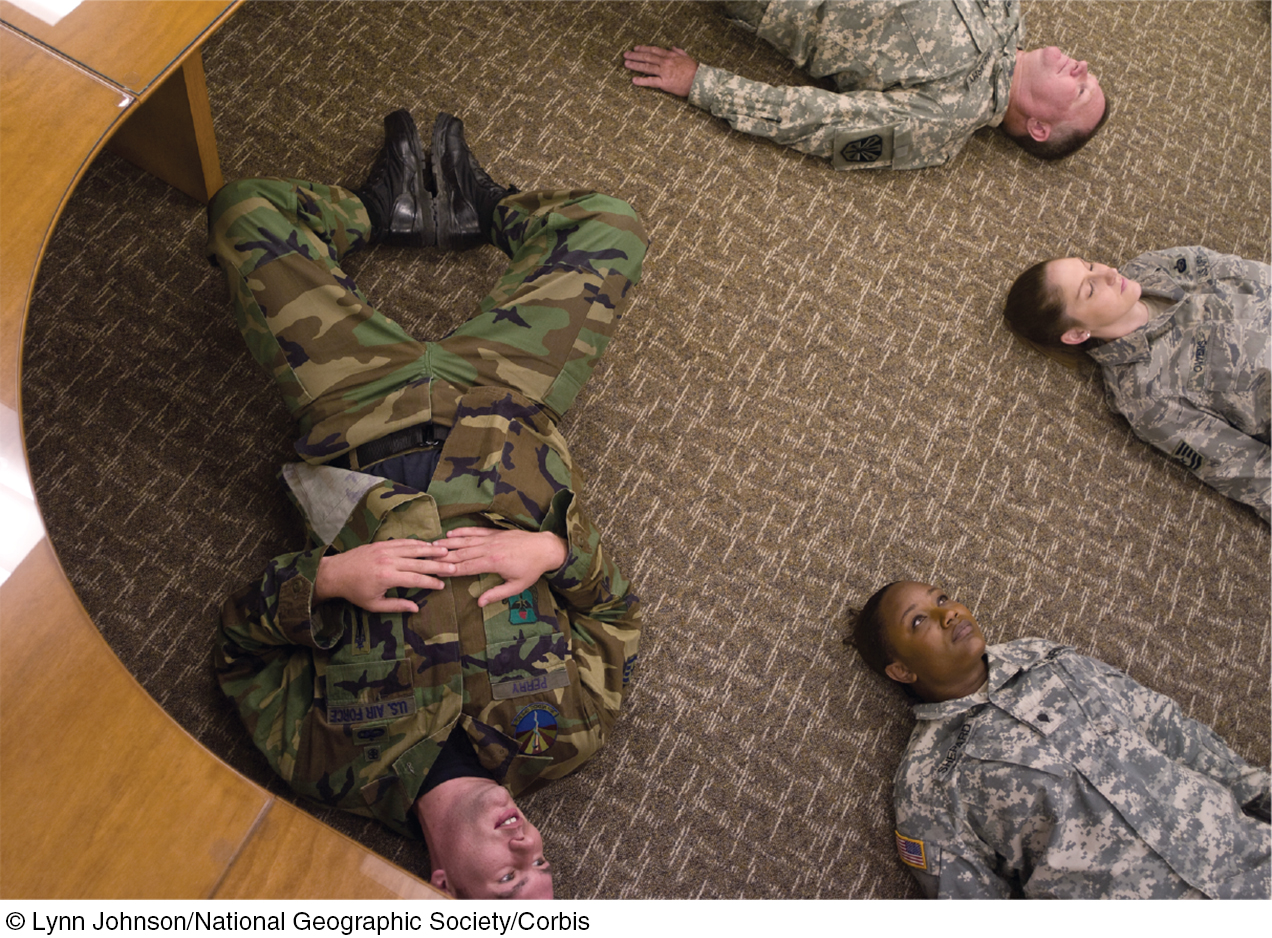14.2 Anxiety Disorders, OCD, and PTSD
Anxiety is part of life. Speaking in front of a class, peering down from a ladder, or waiting to play in a big game might make any one of us feel nervous. Anxiety may even cause us to avoid talking or making eye contact—
Anxiety Disorders
14-
anxiety disorders psychological disorders characterized by distressing, persistent anxiety or maladaptive behaviors that reduce anxiety.
The anxiety disorders are marked by distressing, persistent anxiety and often dysfunctional anxiety-
Generalized anxiety disorder, in which a person is unexplainably and continually tense and uneasy.
Panic disorder, in which a person experiences panic attacks—
sudden episodes of intense dread— and fears the next episode’s unpredictable onset. Phobias, in which a person is intensely and irrationally afraid of a specific object, activity, or situation.
Generalized Anxiety Disorder
Tom was a 27-
generalized anxiety disorder an anxiety disorder in which a person is continually tense, apprehensive, and in a state of autonomic nervous system arousal.
Tom’s unfocused, out-
People may not be able to identify the cause of their anxiety, and therefore cannot relieve or avoid it. To use Sigmund Freud’s term, the anxiety is free-
Panic Disorder
panic disorder an anxiety disorder marked by unpredictable, minutes-
For the 1 person in 75 with panic disorder, anxiety suddenly escalates into a terrifying panic attack—
hot and as though I couldn’t breathe. My heart was racing and I started to sweat and tremble and I was sure I was going to faint. Then my fingers started to feel numb and tingly and things seemed unreal. It was so bad I wondered if I was dying and asked my husband to take me to the emergency room. By the time we got there (about 10 minutes) the worst of the attack was over and I just felt washed out (Greist et al., 1986).
These anxiety tornados strike suddenly, wreak havoc, and disappear, but they are not forgotten. Ironically, worries about anxiety—

Charles Darwin began suffering from panic disorder at age 28, after spending five years sailing the world. As a result, he moved to the country, avoided social gatherings, and traveled only in his wife’s company. But the relative seclusion did free him to develop his evolutionary theory. “Even ill health,” he reflected, “has saved me from the distraction of society and its amusements” (quoted in Ma, 1997).
Smokers have at least a doubled risk of panic disorder (Zvolensky & Bernstein, 2005). They also show greater panic symptoms in situations that often produce panic attacks (Knuts et al., 2010). Because nicotine is a stimulant, lighting up doesn’t help us lighten up.
Phobias
phobia an anxiety disorder marked by a persistent, irrational fear and avoidance of a specific object, activity, or situation.
We all live with some fears. But people with phobias are consumed by a persistent, irrational fear and avoidance of some object, activity, or situation. Specific phobias may focus on particular animals, insects, heights, blood, or closed spaces (FIGURE 14.3). Many people avoid the triggers, such as high places, that arouse their fear. Marilyn2, an otherwise healthy and happy 28-

Not all phobias are so specific. Social anxiety disorder (formerly called “social phobia”) is shyness taken to an extreme. People with this disorder have an intense fear of other people’s negative judgments. They may avoid social situations, such as speaking up in a group, eating out, or going to parties. Finding themselves in such a situation, they may experience symptoms of their anxiety, such as sweating or trembling.
RETRIEVE IT
Question
Unfocused tension, apprehension, and arousal are symptoms of disorder.
Question
Those who experience unpredictable periods of terror and intense dread, accompanied by frightening physical sensations, may be diagnosed with a disorder.
Question
If a person is focusing anxiety on specific feared objects or situations, that person may have a .
Obsessive-Compulsive Disorder
14-
obsessive-compulsive disorder (OCD) a disorder characterized by unwanted repetitive thoughts (obsessions), actions (compulsions), or both.
As with the anxiety disorders, we can see aspects of our own behavior in obsessive-compulsive disorder (OCD). Obsessive thoughts are unwanted and so repetitive it may seem they will never end. Compulsive behaviors are responses to those thoughts.

 For a 7-
For a 7-
We all are at times obsessed with thoughts that will not go away, and we all at times behave compulsively. Anxious about how your place will appear to others, you may catch yourself compulsively cleaning before guests arrive. Concerned that you may not make the grade on your final, you may find yourself lining up books and pencils “just so” before studying. On a small scale, obsessive thoughts and compulsive behaviors are a part of everyday life. They cross the fine line between normality and disorder when they persistently interfere with everyday life and cause us distress. Checking to see that you locked the door is normal; checking 10 times is not. Washing your hands is normal; washing so often that your skin becomes raw is not. (TABLE 14.4 offers more examples.) At some time during their lives, often during their late teens or twenties, some 2 percent of people cross that line from normal preoccupations and fussy behaviors to debilitating disorder (Kessler et al., 2012). Twin studies reveal that OCD has a strong genetic basis (Taylor, 2011). Although the person knows the anxiety-

Data from: Rapoport, 1989.
OCD is more common among teens and young adults than among older people (Samuels & Nestadt, 1997). A 40-
Posttraumatic Stress Disorder
14-
While serving his country in war, one soldier, Jesse, observed the killing “of children and women. It was just horrible for anyone to experience.” After calling in a helicopter strike on one house where he had seen ammunition crates carried in, he heard the screams of children from within. “I didn’t know there were kids there,” he recalled. Back home, he suffered “real bad flashbacks” (Welch, 2005).
posttraumatic stress disorder (PTSD) a disorder characterized by haunting memories, nightmares, social withdrawal, jumpy anxiety, numbness of feeling, and/or insomnia that lingers for four weeks or more after a traumatic experience.
Jesse is not alone. In one study of 103,788 veterans returning from Iraq and Afghanistan, 25 percent were diagnosed with a psychological disorder (Seal et al., 2007). Some had traumatic brain injuries (TBI), but the most frequent diagnosis was posttraumatic stress disorder (PTSD). Typical symptoms include recurring haunting memories and nightmares, a numb feeling of social withdrawal, jumpy anxiety, and trouble sleeping (Germain, 2013; Hoge et al., 2004, 2006, 2007; Kessler, 2000). Survivors of accidents, disasters, and violent and sexual assaults (including an estimated two-
The greater one’s emotional distress during a trauma, the higher the risk for posttraumatic symptoms (Ozer et al., 2003). Among American military personnel in Afghanistan, 7.6 percent of combatants and 1.4 percent of noncombatants developed PTSD (McNally, 2012). Among New Yorkers who witnessed or responded to the 9/11 terrorist attacks, most did not experience PTSD (Neria et al., 2011). PTSD diagnoses among survivors who had been inside the World Trade Center during the attack were, however, double the rates found among those who were outside (Bonanno et al., 2006).

About half of us will experience at least one traumatic event in our lifetime. Why do some 5 to 10 percent of people develop PTSD after a traumatic event, but others don’t (Bonanno et al., 2011)? Some people may have a more sensitive emotion-
Some psychologists believe that PTSD has been overdiagnosed (Dobbs, 2009; McNally, 2003). Too often, say critics, PTSD gets stretched to include normal stress-
Most people, male and female, display an impressive survivor resiliency, or ability to recover after severe stress (Bonanno et al., 2010). For more on human resilience and on the posttraumatic growth that some experience, see Chapter 15.
RETRIEVE IT
Question
Those who express anxiety through unwanted repetitive thoughts or actions may have a(n) - disorder.
Question
Those with symptoms of recurring memories and nightmares, social withdrawal, jumpy anxiety, numbness of feeling, and/or insomnia for weeks after a traumatic event may be diagnosed with disorder.
Understanding Anxiety Disorders, OCD, and PTSD
14-
Anxiety is both a feeling and a cognition—
Conditioning
Some bad events come with a warning. You’re running late and might miss the bus. But when bad events happen unpredictably and uncontrollably, anxiety or other disorders often develop (Field, 2006; Mineka & Oehlberg, 2008). In a classic experiment, infant “Little Albert” learned to fear furry objects that were paired with loud noises. In other experiments, researchers have created anxious animals by giving rats unpredictable electric shocks (Schwartz, 1984). The rats, like assault victims who report feeling anxious when returning to the scene of the crime, learn to become uneasy in their lab environment. The lab had become a cue for fear.
Such research helps explain how panic-
How might learning magnify a single painful and frightening event into a full-
Stimulus generalization occurs when a person experiences a fearful event and later develops a fear of similar events. My [DM’s] car was once struck by another whose driver missed a stop sign. For months afterward, I felt a twinge of unease when any car approached from a side street. Likewise, I [ND] was watching a terrifying movie about spiders, Arachnophobia, when a severe thunderstorm struck and the theater lost power. For months, I experienced anxiety at the sight of spiders or cobwebs. Those fears eventually disappeared, but sometimes fears linger and grow. Marilyn’s thunderstorm phobia may have similarly generalized after a terrifying or painful experience during a thunderstorm.
Once fears and anxieties are learned, reinforcement helps maintain them. Anything that helps us avoid or escape the feared situation reduces anxiety. This feeling of relief can reinforce phobic behaviors. Fearing a panic attack, we may decide not to leave the house. Reinforced by feeling calmer, we are likely to repeat that maladaptive behavior in the future (Antony et al., 1992). So, too, with compulsive behaviors. If washing our hands relieves our feelings of anxiety, we may wash our hands again when those feelings return.
Cognition
Conditioning influences our feelings of anxiety, but so does cognition—

Our interpretations and expectations also shape our reactions. Whether we interpret the creaky sound in the old house simply as the wind or as a possible knife-
Biology
Some aspects of anxiety disorders, OCD, and PTSD are not easily understandable in terms of conditioning and cognitive processes alone. Why do some of us develop lasting phobias after suffering traumas, but others do not? Why do we all learn some fears more readily? Our biology also plays a role.
GENES Among monkeys, fearfulness runs in families. A monkey reacts more strongly to stress if its close biological relatives have sensitive, high-
Given the genetic contribution to anxiety disorders, researchers are now sleuthing the culprit genes. Among their findings are 17 gene variations associated with typical anxiety disorder symptoms (Hovatta et al., 2005), and others that are associated specifically with OCD (Taylor, 2013).
Some genes influence anxiety disorders by regulating brain levels of neurotransmitters. These include serotonin, which influences sleep, mood, and attending to threat (Canli, 2008; Pergamin-
So genes matter. Some of us have genes that make us like orchids—
But experience affects gene expression. Among PTSD patients, a history of child abuse leaves long-
THE BRAIN Our experiences change our brain, paving new pathways. Traumatic fear-
Anxiety-

NATURAL SELECTION We seem biologically prepared to fear the threats our ancestors faced—
Compare our easily conditioned fears to what we do not easily learn to fear. World War II air raids, for example, produced remarkably few lasting phobias. As the air strikes continued, the British, Japanese, and German populations did not become more and more panicked. Rather, they grew increasingly indifferent to planes outside their immediate neighborhoods (Mineka & Zinbarg, 1996). Evolution has not prepared us to fear bombs dropping from the sky.

Our phobias focus on dangers our ancestors faced. Our compulsive acts typically exaggerate behaviors that helped them survive. Grooming had survival value; it detected insects and infections. Gone wild, it becomes compulsive hair pulling. Washing up helped people stay healthy. Out of control, it becomes ritual hand washing. Checking territorial boundaries helped ward off enemies. In OCD, it becomes checking and rechecking an already locked door (Rapoport, 1989).
RETRIEVE IT
Question
Researchers believe that conditioning and cognitive processes contribute to anxiety disorders, OCD, and PTSD. What biological factors also contribute to these disorders?
REVIEW Anxiety Disorders, OCD, and PTSD
Learning Objectives
Test Yourself by taking a moment to answer each of these Learning Objective Questions (repeated here from within the chapter). Research suggests that trying to answer these questions on your own will improve your long-
Question
14-
Question
14-
Question
14-
Question
14-
Terms and Concepts to Remember
Test yourself on these terms.
Question
anxiety disorders (p. 537) generalized anxiety disorder (p. 537) panic disorder (p. 537) phobia (p. 538) obsessive- posttraumatic stress disorder (PTSD) (p. 540) | an anxiety disorder in which a person is continually tense, apprehensive, and in a state of autonomic nervous system arousal. a disorder characterized by haunting memories, nightmares, social withdrawal, jumpy anxiety, numbness of feeling, and/or insomnia that lingers for four weeks or more after a traumatic experience. a disorder characterized by unwanted repetitive thoughts (obsessions), actions (compulsions), or both. an anxiety disorder marked by a persistent, irrational fear and avoidance of a specific object, activity, or situation. psychological disorders characterized by distressing, persistent anxiety or maladaptive behaviors that reduce anxiety. an anxiety disorder marked by unpredictable, minutes- |
Experience the Testing Effect
Test yourself repeatedly throughout your studies. This will not only help you figure out what you know and don’t know; the testing itself will help you learn and remember the information more effectively thanks to the testing effect.
Question 14.9
1. Anxiety that takes the form of an irrational and maladaptive fear of a specific object, activity, or situation is called a .
Question 14.10
2. An episode of intense dread, accompanied by trembling, dizziness, chest pains, or choking sensations and by feelings of terror, is called
| A. |
| B. |
| C. |
| D. |
Question 14.11
3. Marina became consumed with the need to clean the entire house and refused to participate in any other activities. Her family consulted a therapist, who diagnosed her as having - disorder.
Question 14.12
4. When a person with an anxiety disorder eases anxiety by avoiding or escaping a situation that inspires fear, this is called
| A. |
| B. |
| C. |
| D. |
Use  to create your personalized study plan, which will direct you to the resources that will help you most in
to create your personalized study plan, which will direct you to the resources that will help you most in  .
.